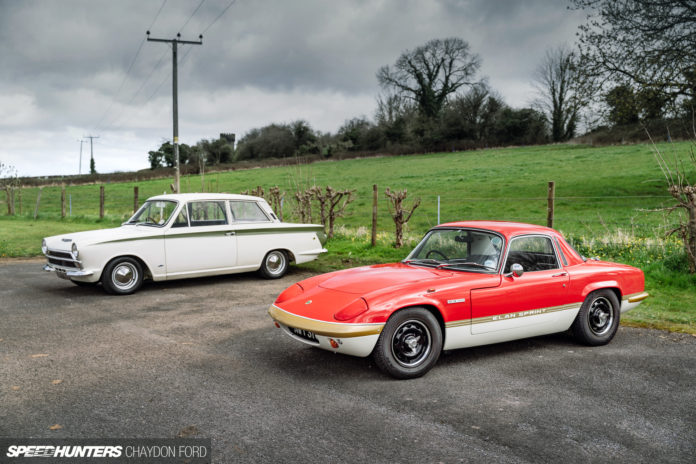The 1960s were a significant time for Lotus. Success on the race track trickled down to the road cars, and Colin Chapman’s company rose up the ranks from a specialist to a major British manufacturer.
Chapman was well known and often quoted for his “Simplify, then add lightness” approach to car building. On the track, his cars were thought of as fast but fragile. On the road, they were revered for their delicate handling characteristics. Two cars that were key in supporting Lotus’s success were the Elan and Cortina. They were different cars built for distinct purposes but shared a degree of commonality in parts and technology.
Seeing either of these cars outside of a historic race event is rare nowadays, but both of them together? That is a real treat. The beauty of the British Sunday morning breakfast meet is that you never know what you will see. In this instance, it was two significant cars from the Lotus history books.

The Lotus Cortina
In 1962, Colin Chapman met with Walter Hayes from the Ford Motor Company to discuss elevating Ford’s motorsport presence in Europe. Hayes was impressed with what Chapman was achieving with Ford Kent-based engines.

Cash-strapped, Chapman was keen to help, and an agreement was made to homologate the Type 74 Cortina 2-door saloon (Mk1) for Group 2 racing. Ford and Lotus did it by building a performance-oriented road car.

Graham Arnold, a former Lotus sales director, once said that Lotus spent the same time designing the Elan and putting it into production as Ford did on the Mk1 Cortina’s bumpers alone. No surprise then that Lotus wasted little time converting the new Cortina from a compact saloon into something special. Chapman code-named the Lotus Cortina project ‘Type 28′.
Cortinas destined to become Lotus variants were partially assembled at the Ford plant in Dagenham before being sent to the Lotus factory in Cheshunt, where they were finished off on the second floor directly above the Elan.

Changes made to the Type 74 Cortina 2-door saloon were substantial.
The car received the Lotus-modified version of Ford’s 116E 1,498cc Kent engine, which was stretched to 1,557cc and equipped with a twin-cam cylinder head, twin side-draught Weber carburettors and a free-flowing exhaust system. Furthermore, a Lotus Elan close-ratio gearbox was installed, the suspension was upgraded – significantly at the rear – better brakes were added, and a lightweight aluminium bonnet, boot lid and doors fitted, as were front corner bumpers in place of a complete unit. Bar some cars that Ford raced, all Lotus Cortinas were painted white, with green stripes.

Inside the car, the performance intent was reflected in different seats, a wood-rimmed sports steering wheel and a new gauge cluster.

The 105hp that the Mk1 Lotus Cortina produced may not seem like much today, but that horsepower figure coupled with a sub-900kg weight in race trim saw the car take numerous trophies and championships across the UK, USA, Africa and Europe before the Mk2 Lotus Cortina appeared in 1966.

The Lotus Elan
First released in 1962, the Elan was the first of many Lotus designs to use a steel backbone and fibreglass body construction, achieving a scant 688kg kerb weight.


The Elan is regarded as one of the most successful sports cars of all time and was the first Lotus to have four-wheel disc brakes, rack and pinion steering, and independent suspension all around. Many of its components were borrowed from the Ford parts bin, of which Chapman had access to.

If the Mk1 Cortina is small by contemporary standards the Elan is tiny. It is so small, in fact, that its 155/80R13 tyres mounted on 13×4.5-inch wheels look big.
The Elan Sprint pictured here was effectively the runout model. It took the Series 4 Elan and further modified it, culminating in 126hp from the Lotus twin-cam engine and a 0-60mph time of under 7 seconds.

Chapman always intended for the Elan to exist solely as a road car, but all the characteristics that made it a great road car meant it had all the makings of great race car, too. An estimated 97 Elans were homologated as the 26R variant. Further upgrades were made, resulting in a car that weighed around 600kg and produced up to 175hp, which saw it competitive against cars one class up.
Modern safety regulations, fleet emissions, and an increasing demand for crossovers and SUVs are all factors that weigh on Lotus today, and this has resulted in some compromises being made in its current product lineup. Despite all this, Lotus still retains its strong brand identity. Even though the current Lotus Emira weighs in at 1,440kg (light compared to its competition), the DNA can still be traced back to cars like the Elan and Lotus Cortina.
While we must accept that time has moved on, and it is unlikely we will ever see cars this light again, it just means we have to appreciate them on the rare occasion they appear on a Sunday morning.
If the keys for both cars were on the table, which one would you be taking for a drive?
Chaydon Ford
Instagram: chaycore









